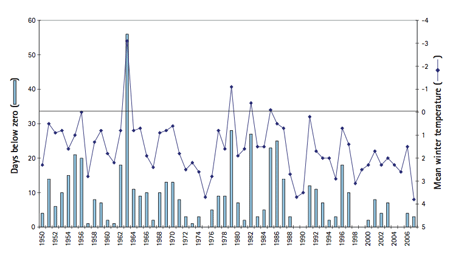Climatic change

Figure 1: Annual surface air temperatures for central England
(a roughly triangular area enclosed by Bristol, Lancashire and London)
from 1772 to the present, with the red line the 10-year running mean
(http://www.metoffice.gov.uk/hadobs/hadcet/).
We are now in the warmest period on record since the Industrial Revolution, illustrated by the graph of mean temperatures (Figure 1).
With this warming trend, it is perhaps not surprising that the county has been colonized by several species with a southerly distribution, such as Hobby, Little Egret, Avocet and Mediterranean Gull. Others have continued to spread northwards, including Reed Warbler, and the increased range of the Red-legged Partridge has probably been helped by the warmer weather. It would be too naive, however, to assume that southerly species are thriving and several have declined considerably, notably Turtle Dove, Tree Pipit and Wood Warbler, with Nightjar showing little sign of recolonizing the county. And, further confounding the picture, Siskin has now spread from the north to establish itself as a regular breeder in Cheshire.

Figure 2: Winter (December to February inclusive) seasonal average temperature and
the number of subzero days for central England from 1949/50 to 2006/07
(Created from data at http://www.metoffice.gov.uk/hadobs/hadcet/data/download.html).
At least as big an effect of the changing climate has been in winter, where the graph of winter temperatures (Figure 2) particularly shows the lack of hard weather since 1986. This has changed the habits of some birds during winter itself, and also throughout the year. In winter, since the mid-1980s there have been no significant hard weather movements of species like Lapwing, some waterfowl and some thrushes. The milder winters have probably contributed to the increasing numbersof wintering warblers, especially the regular Chiffchaff and Blackcap, and must help the survival of rare wintering birds such as Swallow, Pallas's Warbler and Yellow-browed Warbler, all recorded during this Atlas. The wintering numbers and distribution in the county of partial migrants such as Stonechat, Goldfinch and Reed Bunting have undoubtedly increased.
Severe winter weather used to limit the populations of a range of resident species, which have not been restricted by this cause for over 20 years. The breeding numbers of fish-eating birds of fresh water, such as Grey Herons, are now at their highest recorded level in Cheshire and Wirral. Small insectivorous species have undoubtedly benefited from the mild winters: Long-tailed Tit and Goldcrest are much more widespread in the county than in our First Atlas, and Wren is the most ubiquitous breeder. Grey Wagtails have probably prospered from the same cause.
Climatic change outside Britain
Many trans-Saharan migrants are decreasing in range and numbers, at least in part owing to conditions experienced on migration and in their winter quarters. The widening Sahara and reduced rainfall in western Africa, particularly from 1968 to 1984, severely reduced the overwinter survival, especially of species that winter in the Sahel including Sand Martin, Sedge Warbler and Whitethroat, but they have largely adapted to their changed winter conditions and the latter two species are slightly more widespread now than during our First Atlas.
The Cheshire and Wirral breeding populations of several species that winter in West Africa have declined greatly, such as Turtle Dove, Yellow Wagtail, Whinchat, Redstart, Garden Warbler, Willow Warbler and Pied Flycatcher. Most of the longer-distance migrants have also decreased their numbers or range, notably Cuckoo, Tree Pipit, Wood Warbler and Spotted Flycatcher all dropping substantially, with House Martin also occupying fewer tetrads than in 1978–84. The reasons for these declines are not well understood and urgently need more study.
The warming climate is apparently allowing more Chiffchaffs and Blackcaps to winter around the Mediterranean and not cross the Sahara, benefiting them in earlier spring returns and nesting, and both species are present in considerably more tetrads now than twenty years ago.
A similar effect is applying to some of our wintering birds, notably with a tendency for waterfowl to winter closer to their breeding grounds. Birds from the east, especially those breeding in Siberia, are reaching here in smaller numbers, such as Bewick's Swan, Pochard and Grey Plover. On the other hand, the numbers of some of the species breeding to the north-west (Iceland, Greenland and Canada) are increasing here, as fewer winter in continental Europe, such as Knot, Black-tailed Godwit and Redshank.
Another effect of climate change is an increasing frequency of extreme weather events including more strong winds. Perhaps the weather pattern in November and December 2006 in the Bay of Biscay, driving some seabirds out of their winter quarters, is an example.

